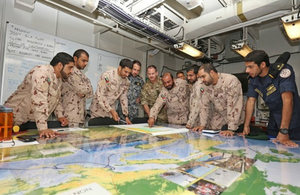British and Emirati forces conduct joint exercises
HMS OCEAN demonstrates its flexibility, capacity and capability during simultaneous joint exercises with the UAE and partners in the region.

Emirati staff conducting a planning exercise in HMS Ocean prior to the Ex SEA KHANJAR 17 final assault
The Royal Navy Commodore, Andrew Burns, who is currently embarked on HMS OCEAN, took command of the US Task Force responsible for maritime security operations in The Gulf in November last year. Since then, the forces on board OCEAN have conducted a number of high-tempo capacity-building exercises with partners in the region.
“Exercise Sea Khanjar 17” saw British and Emirati forces work together for two weeks. This included the UK’s elite Special Purpose Task Group deploying into the desert of Abu Dhabi. These elite marines, alongside their Emirati counterparts, conducted high-intensity training, including beach reconnaissance, close quarter battle training, counter explosive training, marksmanship and first aid.
The successful landing of helicopters from the UAE Joint Aviation Command on HMS OCEAN proved the potential for further co-operation between HMS OCEAN and regional partners.
The highlight and conclusion of the joint exercise was an amphibious assault on the UAE coast conducted jointly from HMS OCEAN by the Special Purpose Task Group and the elite Emirati Al Forsan Presidential Guard.
Exercise Sea Khanjar was conducted at the same time as a joint exercise with the Qatari Navy, and only days after exercises in Kuwait. These demonstrate HMS OCEAN’s flexibility, capacity and level of preparedness for its mission to protect the security of the Gulf.
Further information
HMS Ocean is the Royal Navy’s Landing Platform Helicopter (LPH). A helicopter carrier and amphibious assault ship, HMS OCEAN, is designed to deliver troops to the centre of the action by helicopter or by landing craft. Aviation capabilities include six helicopter operating spots on her flight deck, with space in the hangar to hold, transport and maintain many more aircraft. HMS OCEAN’s Ship’s Company of 400 personnel includes 9 Assault Squadron Royal Marines (9 ASRM), who operate the four Mk5 landing craft for vehicles and personnel (LCVP) and provide the projection of fighting capability ashore for HMS OCEAN. The 21,500-tonne amphibious assault ship was launched in 1995 and has a top speed of 16 knots and a range of 8,000 miles.
HMS OCEANis the Royal Navy’s largest operational ship is currently the Fleet Flagship and the at-sea-and-ready LPH for the UK and NATO. She is trained and prepared to take on any tasking required of her and is at 5 days notice to sail to anywhere in the world where she may be needed. HMS OCEANprovides the UK government’s most flexible and agile platform and is able to embark up to 1100 personnel and act as a command platform.
Commodore Andrew Burns, the Commander of the Royal Navy’s Amphibious Task Group, took charge of the US Task Force in November 2016. Commodore Burns is currently embarked on HMS OCEAN. Along with Type 45 destroyer HMS Daring, HMS OCEANis providing maritime security through its continued presence in the Gulf region following the departure of USS Dwight D Eisenhower.